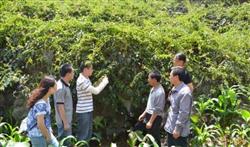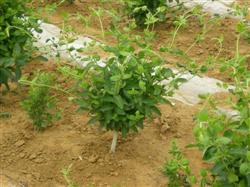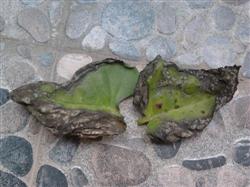Honeysuckle planting: how to manage honeysuckle after harvest?

How to manage honeysuckle after harvest? What should I pay attention to? Hope experienced netizens help introduce Honeysuckle post-harvest management mainly includes pruning, garden cleaning, fertilizer and water management and pest control. For detailed operation, please refer to the following introduction. I. Honeysuckle pruning: Pruning method 1, thinning: thinning out serious pest branches, dry branches, dense weak branches, cross branches and excessive long branches with improper growth position. The aim is to reduce unnecessary nutrient consumption and water evaporation. Pruning method 2, short cut: cut off part of the current year's branches. Cultivate healthy shoots to make the tree compact and plump. Pruning Method III. Retraction: A pruning method for perennial branches. Pruning method four, long put: the new planting or young tree part of the branches are not pruned, let it grow. 2. Honeysuckle Garden Cleaning Method: Many honeysuckle growers failed to clean and disinfect the honeysuckle garden in time, resulting in aggravation of diseases and insect pests and decrease of yield. Therefore, it is suggested that after pruning, on the one hand, the diseased branches should be picked up in time for deep burial treatment, on the other hand, the dry branches, dense weak branches, cross branches and excessive long branches with improper attachment should be picked out of the garden for treatment. After clearing the garden, disinfect the whole garden once, spray 75% carbendazim or 15% triadimefon mixed with water per mu to reduce the occurrence of diseases. 3. Honeysuckle fertilizer water management method: 1. Intertill weeding: After harvest, carry out intertill weeding for those who have not planted any crops to enhance root activity and reduce weed growth. 2, topdressing fertilizer: because after the flower production, most of the nutrients have been taken away, in order to quickly restore the tree, enhance tree nutrition, must topdressing a fertilizer, mainly farm manure and amino acid compound fertilizer. Fertilization depends on the size of the plant clusters, in general, each plant fertilizer 1 kg, amino acid compound fertilizer 2-4 liang. Fertilization should be applied in circular furrows around the plant clusters, and then covered with soil to avoid fertilizer loss. IV. Prevention and control of honeysuckle diseases and pests: 1. The harm of honeysuckle powdery mildew: mainly harmful to leaves, the disease spots are white dots, the later stage expands into white powdery spots, and finally the whole leaves are covered with white powder layers, and when it is serious, the yellow leaves are deformed, the flowers are distorted and fall off. Control methods of honeysuckle powdery mildew: (1), timely pruning, timely removal of sick branches, sick leaves, pruning branches, litter. (2), shoot pumping to the disease before the mu with 75% Antaisheng powder 100 grams of water 50-60 kg spray prevention. (3) At the initial stage of disease, 5% flusilazole 30g +75% Antaisheng WP 100g, or 43% Holic SC 18ml +75% Antaisheng WP 100g, or Luheng 80% more. family photos. Zinc (No. 2) wettable powder 40g, water 50- 60kg spray, spray once every 10 days, continuous 2-3 times. The last application should be 10-15 days before picking, and pesticides are prohibited during flower picking. 2. Harm of honeysuckle brown spot: It mainly damages leaves, yellow brown spots appear on the leaves in the early stage of disease, and brown round spots or irregular spots form in the late stage. The disease first appeared at the end of April and was more serious from June to August. Control method of honeysuckle brown spot disease: spray 70% thiophanate-methyl WP 800 times or 70% mancozeb WP 800 times every 7-10 days, spray 2-3 times continuously, pay attention to alternate application, and have good control effect. 3. The harm of scarab (larva grub, commonly known as mother worm) to honeysuckle: The larvae bite lateral roots and taproots, but the damage is serious from April to May and from late August to early September. Control methods for chafers: (1) Artificial killing, light trapping and avoiding the application of undecomposed manure to reduce the number of eggs laid by adults in the field. (2) Poison soil treatment is carried out from late March to mid April and from late August to early September. 500g of 10% diazinon granules are mixed with 20kg of poison soil per mu, or 200g of 40% diazinon emulsifiable concentrate is mixed with 20- 25kg of fine soil per mu. Mix well and cover after furrow application. (3) Root irrigation: In the field where white grubs occur heavily, 480 g/L chlorpyrifos 1000 times solution or 40% diazinon EC 1000 times solution is used per mu to irrigate the roots, and 150- 250 ml per plant can kill the larvae near the rhizosphere. 4. Harm of aphids (commonly known as Tianbuyan) to honeysuckle: Most of them occur in the first and middle of April, and the insect situation is serious from May to June. It mainly harms the new leaves and vine shoots of honeysuckle, causing curling, affecting the growth and resulting in low yield of honeysuckle. Aphid control methods: (1) To kill overwintering aphids by spraying sulfur mixture once before germination. (2) From late April to early May, apply 24ml of 10% pymetrozine suspension, or 70% Amira water dispersible granules, or 6g of 70% imidacloprid wettable powder, 50- 60kg of water for foliar spray. The last application should be 10-15 days before picking. Pesticides should be banned during flower picking period. 1kg washing powder can be sprayed on 10kg water or 1kg alcohol can be sprayed on 100kg water. 5, yellow ants harm to honeysuckle: From late March to early April, it began to bite roots, bark and damage trunks, causing yellow leaves, withered branches and tree death. Yellow ant control method: mu with 48% chlorpyrifos emulsifiable concentrate 1000 times the liquid base spraying. 6, red spider harm to honeysuckle: Early symptoms, leaves lose green, leaf edge upward roll, so that scorched, fall off, causing early bud atrophy, serious plant death. Red spider occurs 7-8 generations a year, starts to harm from March to April every year, and seriously harms from June to July. After the end of April, the plants should be observed and inspected frequently. Under the conditions of high temperature, high humidity and poor ventilation, red spiders reproduce very fast, which is one of the important reasons for plant death. Red spider control methods: April, mid-mu with 73% promite EC 2000 times solution, 5% Nisolon EC 2000 times solution foliar spray. Click to get more honeysuckle planting technology Click to get more herbs planting technology
- Prev

Honeysuckle planting: how to water and fertilize honeysuckle?
How to water and fertilize honeysuckle? Hope that experienced netizens can refer to the following methods to fertilize and water honeysuckle: 1. The fertilization method of honeysuckle: in order to alleviate the contradiction between the growth and budding of honeysuckle and meet the needs of bud development, topdressing should be carried out after each harvest of buds.
- Next

Honeysuckle planting techniques: how to prevent and control anthracnose of honeysuckle?
What harm does anthrax do to honeysuckle? How to prevent and cure anthracnose of honeysuckle? Ask experienced friends to introduce the harm of anthrax to honeysuckle: anthracnose is a fungal disease, the diseased leaves show a variety of disease spot symptoms, when wet, the disease spot is covered with reddish-brown spot-like adhesive, which can be caused in serious cases.
Related
- Fuxing push coffee new agricultural production and marketing class: lack of small-scale processing plants
- Jujube rice field leisure farm deep ploughing Yilan for five years to create a space for organic food and play
- Nongyu Farm-A trial of organic papaya for brave women with advanced technology
- Four points for attention in the prevention and control of diseases and insect pests of edible fungi
- How to add nutrient solution to Edible Fungi
- Is there any good way to control edible fungus mites?
- Open Inoculation Technology of Edible Fungi
- Is there any clever way to use fertilizer for edible fungus in winter?
- What agents are used to kill the pathogens of edible fungi in the mushroom shed?
- Rapid drying of Edible Fungi

